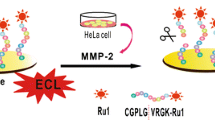Abstract
We developed a new high-throughput approach to measure matrix metalloproteinase (MMP)-3 activity using Cy3-conjugated gelatin arrays. We fabricated Cy3-conjugated gelatin arrays by immobilizing Cy3-conjugated gelatin onto well-type amine arrays. The ratio of Cy3-NHS to gelatin was optimized to improve the efficiency of the arrays. MMP-3 activity was determined by the decrease of fluorescence intensity due to MMP-3-mediated degradation of Cy3-conjugated gelatin. The gelatinolytic activity of MMP-3 increased in the presence of Brij-35, a non-ionic detergent, in a dose-dependent manner. Cy3-conjugated gelatin arrays were successfully applied for the analyses of MMP-3 activity, which showed a dose-dependent degradation of the Cy3-conjugated substrate. This chip-based activity assay using a Cy3-conjugated gelatin array is simple, rapid, cost-effective, and has a potential for activity-based proteomic researches and screening of MMP-3 inhibitors.
Similar content being viewed by others
References
Birkedal-Hansen, H. Proteolytic remodeling of extracellular matrix. Curr. Opin. Cell Biol. 7, 728–735 (1995).
Murphy, G.J., Murphy, G. & Reynolds, J.J. The origin of matrix metalloproteinases and their familial relationships. FEBS. Lett. 89, 4–7 (1991).
Nagase, H. & Woessner, J.F. Jr. Matrix metalloproteinase. J. Biol. Chem. 274, 21491–21494 (1999).
Skiles, J.W., Gonnella, N.C. & Jeng, A.Y. The design, structure, and therapeutic application of matrix metalloproteinase inhibitors. Curr. Med. Chem. 8, 425–474 (2001).
Bertini, I. et al. Snapshots of the reaction mechanism of matrix metalloproteinases. Angew. Chem. Int. Ed. Engl. 45, 7952–7955 (2006).
Alcaraz, L.A. Matrix metalloproteinase-inhibitor interaction: the solution structure of the catalytic domain of human matrix metalloproteinase-3 with different inhibitors. J. Biol. Inorg. Chem. 12, 1197–1206 (2007).
Si-Tayeb, K. et al. Matraix metalloproteinase 3 is present in the cell nucleus and is involved in apoptosis. Am. J. Pathol. 169, 1390–1401 (2006).
Vihinen, P. & Kähäri, V.M. Matrix metalloproteinases in cancer: prognostic markers and therapeutic targets. Int. J. Cancer 99, 157–166 (2002).
Hiller, O., Lichte, A., Oberpichler, A., Kocourek, A. & Tschesche, H. Matrix metalloproteinases collagenase-2, macrophage elastase, collagenase-3, and membrane type 1-matrix metalloproteinase impair clotting by degradation of fibrinogen and factor XII. J. Biol. Chem. 275, 33008–33013 (2000).
Visse, R. & Nagase, H. Matrix metalloproteinases and tissue inhibitors of metalloproteinases: structure, function, and biochemistry. Circ. Res. 92, 827–839 (2003).
Jung, S.H. et al. Rapid analysis of matrix metalloproteinase-3 activity by gelatin arrays using a spectral surface plasmon resonance biosensor. Analyst 135, 1050–1057 (2010).
Dodge, G.R. & Jimenez, S.A. Glucosamine sulfate modulates the levels of aggrecan and matrix metalloproteinase-3 synthesized by cultured human osteoarthritis articular chondrocytes. OsteoArthritis and Cartilage 11, 424–432 (2003).
Kirkegaard, T., Hansen, A., Bruun, E. & Brynskov, J. Expression and localization of matrix metalloproteinases and their natural inhibitor in fistulae of patients with Crohn’s disease. Gut. 53, 701–709 (2004).
Vessillier, S., Adams, G. & Chernajovsky, Y. Latent cytokines: development of novel cleavage sites and kinetic analysis of their differential sensitivity to MMP-1 and MMP-3. Protein Eng. Des. Sel. 17, 829–835 (2005).
Lauer-Fields, J.L. et al. High throughput screening of potentially selective MMP-13 exosite inhibitors utilizing a triple-helical FRET substrate. Bioorg. Med. Chem. 17, 990–1005 (2009).
Yang, J. et al. Detection of MMP activity in living cells by a genetically encoded surface-displayed FRET sensor. Biochim. Biophys. Acta 1773, 400–407 (2007).
Ouyang, M., Sun, J., Chien, S. & Wang, Y. Determination of hierarchical relationship of Src and Rac at subcellular locations with FRET biosensors. Proc. Natl. Acad. Sci. USA 105, 14353–14358 (2008).
Kim, Y.P. et al. Energy transfer-based multiplexed assay of proteases by using gold nanoparticle and quantum dot conjugates on a surface. Anal. Chem. 80, 4634–4641 (2008).
Zhu, H. & Snyder, M. Protein chip technology. Curr. Opin. Chem. Biol. 7, 55–63 (2003).
Yuk, J.S. & Ha, K.S. Proteomic applications of surface plasmon resonance biosensors: analysis of protein arrays. Exp. Mol. Med. 37, 1–10 (2005).
MacBeath, G. & Schreiber, S.L. Printing proteins as microarrays for high-throughput function determination. Science 289, 1760–1763 (2000).
Stears, R.L., Martinsky, T. & Schena, M. Trends in microarray analysis. Nat. Med. 9, 140–145 (2003).
Yang, J. et al. Detection of MMP activity in living cells by a genetically encoded surface-displayed FRET sensor. Biochim. Biophys. Acta 1773, 400–407 (2007).
Cheng, D., Shen, Q., Nan, F., Qian, Z. & Ye, Q.Z. Purification and characterization of catalytic domains of gelatinase A with or without fibronectin insert for high-throughput inhibitor screening. Protein Expr. Purif. 27, 63–72 (2003).
Eastoe, J.E. The amino acid composition of mammalian collagen and gelatin. Biochemical Journal 61, 589–600 (1955).
Miller, J.C. et al. Antibody microarray profiling of human prostate cancer sera: antibody screening and identification of potential biomarkers. Proteomics 3, 56–63 (2003).
Wustneck, R., Wetzel, R., Buder, E. & Hermel, H. The modification of the triple helical structure of gelatin in aqueous solution. I. The influence of anionic surfactants, pH-value, and temperature. Colloid Polym. Sci. 266, 1061–1067 (1988).
Ye, G.Z., Johnson, L.L., Hupe, D.J. & Baragi, V. Purification and characterization of the human stromelysin catalytic domain expressed in Escherichia coli. Biochemistry 31, 11231–11235 (1992).
Koo, M.H. et al. Refolding of the catalytic and hinge domains of human MT1-mMP expressed in Escherichia coli and its characterization. Mol. Cells 13, 118–124 (2002).
Jung, J.W. et al. Label-free and quantitative analysis of C-reactive protein in human sera by tagged-internal standard assay on antibody arrays. Biosens. Bioelectron. 24, 1469–1473 (2009).
Author information
Authors and Affiliations
Corresponding author
Rights and permissions
About this article
Cite this article
Kong, DH., Jung, SH., Lee, ST. et al. On-chip assay of matrix metalloproteinase-3 activity using fluorescence-conjugated gelatin arrays. BioChip J 4, 210–216 (2010). https://doi.org/10.1007/s13206-010-4308-4
Received:
Accepted:
Published:
Issue Date:
DOI: https://doi.org/10.1007/s13206-010-4308-4



